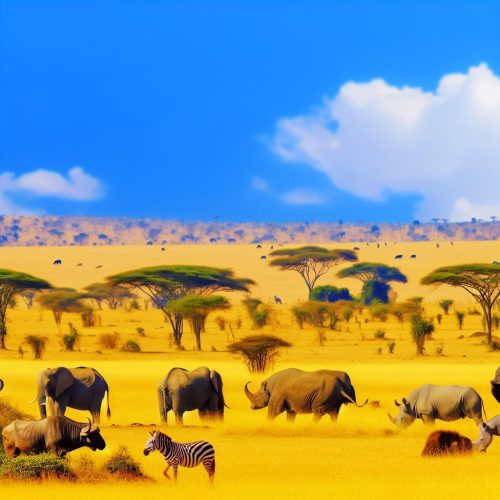Expanding the Horizons of Big Five Safaris in Kenya
Kenya is a land teeming with breathtaking wildlife, offering a unique and transformative experience for adventurers and nature enthusiasts alike. Within its vast savannahs, lush forests, and arid plains, the country provides an epitome of quintessential African wilderness. One of the primary attractions for many nature lovers heading to Kenya is the opportunity to witness the renowned “Big Five” animals. These majestic creatures symbolize the ultimate safari experience and have become the sought-after highlights for travelers around the globe.
The Big Five in Kenya: A Closer Exploration
The term “Big Five” hails from a historical context where these five animals were considered the most challenging to hunt on foot. Today, however, the phrase has taken on a more conservation-oriented and touristic significance, representing not a challenge to hunt, but a challenge to behold in the wild. These animals include the African elephant, the lion, the cape buffalo, the leopard, and the rhinoceros.
Elephants are an intrinsic part of Kenya’s wildlife and serve as a beacon of the country’s conservation success stories. With an estimated population of over 12,000 elephants in Amboseli and Tsavo National Parks alone, and frequent sightings in the abundant landscapes of the Maasai Mara, visitors have various opportunities to appreciate these incredible creatures. Elephants are known for their intelligence, memory, and complex social structures, making them captivating subjects for both observation and study.
Lions, often referred to as the “king of the jungle,” exhibit beauty and formidable strength that remains unparalleled. These majestic cats are predominantly found in the Maasai Mara, where they are frequently observed during the spectacular Great Migration. This period, filled with bountiful prey, lends itself to thrilling predator observations and an in-depth understanding of the lion’s role in the ecosystem.
Buffalo are awe-inspiring in their sheer size and tenacity. As one of Africa’s most formidable creatures, buffaloes are known to roam in substantial herds across the savannah, particularly in the Amboseli, Maasai Mara, and Tsavo regions. The sight of these imposing animals moving in unison against the rolling landscapes of Kenya is a memory to cherish.
Leopards inhabit areas such as the Laikipia Plateau and Samburu National Reserve, where their elusive and solitary nature is most observed. The exploration of these habitats with a keen eye and an experienced guide could lead to the mesmerizing experience of spotting a leopard in the wild, possibly showing their characteristic agility and grace amidst the trees or on hidden trails.
Rhinoceroses have become the face of conservation efforts due to their critically endangered status. Kenya maintains pivotal populations within protected regions like Lake Nakuru and Ol Pejeta Conservancy. These sanctuaries have played a significant role in the resurgence and protection of rhino numbers through dedicated efforts and sustainable practices, ensuring that travelers continue to witness these incredible animals.
Notable Safari Parks in Kenya
Kenya offers an array of safari parks and reserves, each with distinct allure and immense diversity in wildlife and terrain:
Maasai Mara National Reserve is synonymous with the Great Migration and a plethora of wildlife diversity. This iconic reserve provides a remarkably immersive safari experience, often hailed as one of the world’s premier wildlife spectacles. The opportunities for observing dynamic ecosystems and interactions make this a must-visit for enthusiasts. Further details about this majestic site can be found on the official Maasai Mara website.
Amboseli National Park, nestled at the base of Mount Kilimanjaro, is renowned for its vast elephant populations and breathtaking vistas of the towering mountain. Photographers and nature lovers are often amazed by the stunning contrasts and spectacles provided by both the wildlife and scenery.
Tsavo National Parks (East and West) together form one of the largest wildlife refuges in the world. Known for their unique red elephants due to the reddish earth characteristic to the area, Tsavo offers rugged landscapes where vast herds of elephants roam, alongside other iconic African wildlife.
Lake Nakuru National Park is celebrated not only for hosting the Big Five but also for its vibrant display of flamingos that throng the shores. This confluence of avian and terrestrial wildlife offers a distinctive safari experience, lending itself to diverse wildlife viewing and appreciation.
Planning Your Safari Adventure
For those preparing to embark on a Kenyan safari adventure, strategic planning is essential to maximize this unique experience. Timing plays a pivotal role in optimizing wildlife sightings due to the intrinsic link between animal movements and seasonal cycles. The dry season, lasting from June to October, is often deemed the prime time to visit. This period sees animals congregating around water sources, simplifying observation. Moreover, for travelers interested in witnessing the dramatic Great Migration, the months of July to October are especially favorable in the Maasai Mara.
Conservation and Sustainability Efforts in Kenya
Kenya stands at the forefront of global conservation efforts, prioritizing the preservation of its unparalleled ecosystems and species diversity. These initiatives, vital for sustaining Kenya’s natural heritage, urge visitors to adopt eco-friendly tourism practices. By choosing reputable and sustainable tour operators, and seeking accommodations that support conservation, tourists contribute positively to local efforts. The focus on responsible tourism helps ensure that these natural resources are available for future generations to enjoy, thus safeguarding Kenya’s status as a premier wildlife destination.
